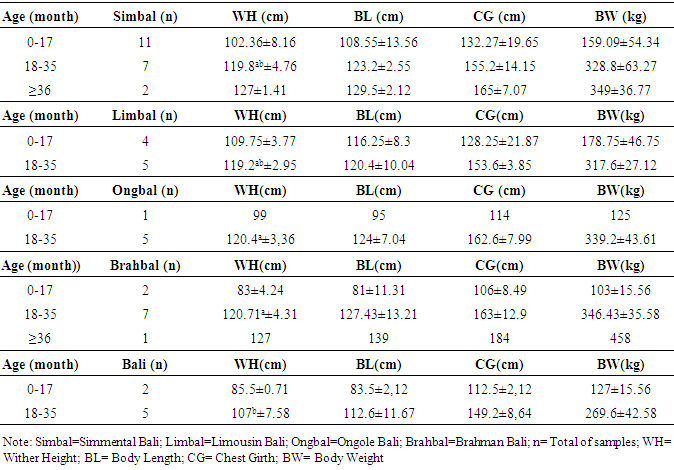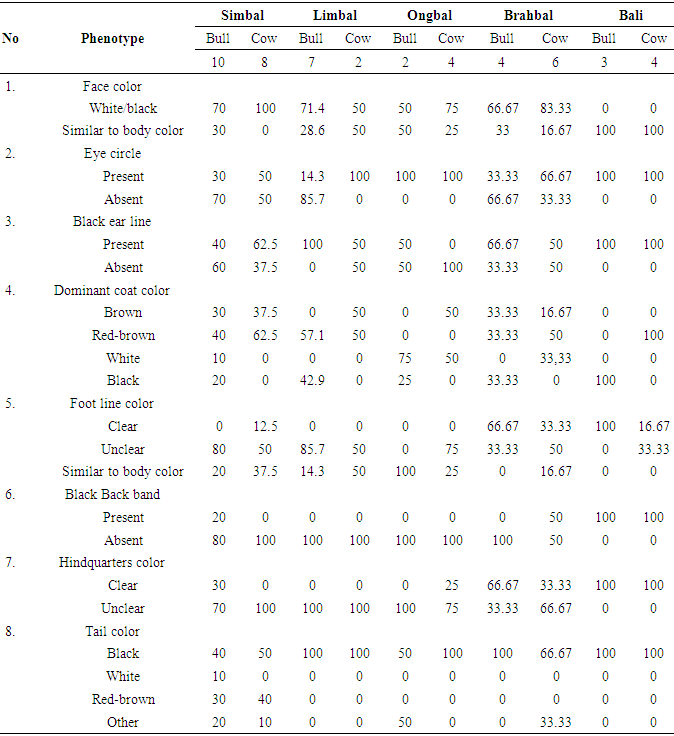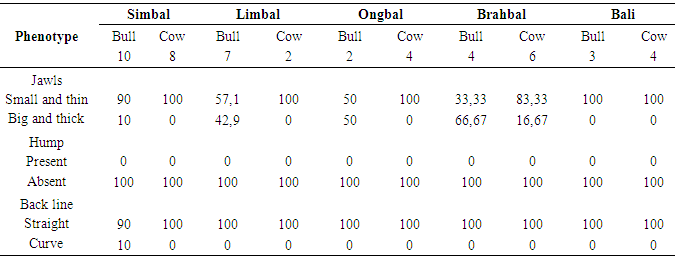-
Paper Information
- Paper Submission
-
Journal Information
- About This Journal
- Editorial Board
- Current Issue
- Archive
- Author Guidelines
- Contact Us
Research in Zoology
p-ISSN: 2325-002X e-ISSN: 2325-0038
2016; 6(1): 1-7
doi:10.5923/j.zoology.20160601.01

Evaluating Performance of Crossbreed Calves in Manokwari, West Papua, Indonesia
Ghalih Priyo Dominanto, Moch. Nasich, Sri Wahyuningsih
Faculty of Animal Husbandry, University of Brawijaya, University of Brawijaya, Malang, Indonesia
Correspondence to: Ghalih Priyo Dominanto, Faculty of Animal Husbandry, University of Brawijaya, University of Brawijaya, Malang, Indonesia.
| Email: |  |
Copyright © 2016 Scientific & Academic Publishing. All Rights Reserved.
This work is licensed under the Creative Commons Attribution International License (CC BY).
http://creativecommons.org/licenses/by/4.0/

The study aim is to evaluate the performance of crossbreed calves in Manokwari, west papua, Indonesia. The parameters were used for evaluating that are quantitative traits (wither height, body length, chest girth, body weight) and qualitative traits (phenotypes) in sub-district of Prafi in Manokwari district. The result showed that crossbreeding with artificial insemination between Bali cattle and breed Simmental, Limousine, Ongole and Brahman likely produce breed calves with better performance indicated by body size such as wither height, body length, chest girth, body weight and increasing body weight compared to Bali cattle. Phenotype analysis showed all croosbreeding cattle have various phenotypes. It can be concluded that crossbreed Brahman-Bali (Brahbal) likely showed better performance than other breeds.
Keywords: Performance, Crossbreed, Body measurement, Bali cattle, Manokwari
Cite this paper: Ghalih Priyo Dominanto, Moch. Nasich, Sri Wahyuningsih, Evaluating Performance of Crossbreed Calves in Manokwari, West Papua, Indonesia, Research in Zoology , Vol. 6 No. 1, 2016, pp. 1-7. doi: 10.5923/j.zoology.20160601.01.
Article Outline
1. Introduction
- Manokwari, West Papua, Indonesia develop Bali cattle breeding, But it has some serious problems such as Productivity of Bali cattle are considered low. There is tendency of decreased genetic quality of Bali cattle as shown in decreasing of body size [1]. Local goverment support the program for cattle breeding center in Manokwari. The goverment provide Bali cattle and crossbreeding program using artificial insemination (AI) from several superior breeds such as Simmental, Limousin, Brahman, Ongole and Bali cattle.Semi-intensive strategy or traditional livestock is used for keeping the cattle in Manokwari. This strategy affect to cattle growth and reproduction. So, they use AI program for the solving this problem. Therefore, evaluating the AI program is necessary to know the successful strategy. The study aim is to evaluate the performance of crossbreed calves cattle in Manokwari, west papua, Indonesia.
2. Materials and Methods
- Research was done with direct survey method all AI center in Prafi. AI center have a program of crossbreeding between Bali cattle and some bulls breeds (Simental, Limousin, Ongole, Brahman and Bali) [2]. 37 cattle mans were involved and 50 breeds (breeds of Simental x Bali, Limousin x Bali, Ongole x Bali and Bali x Bali.) were used for research sample. Performance formula was used for performance analysis [3]:


2.1. Sample Collection
- There were five groups observed in this study: first offspring of breeds, cement, age of cattle. Parameter of performance analysis that are body length (BL), chest girth (CG), wither height (WH), body weight (BW). Weighing was performed twice a week. Primary and secondary data were obtained such as presence of jawls, predominant skin color, border line of body color and ass, tail color, color of line of body and leg, tail color, black eye circle, lack backline, and presence of horn and its direction, and hump. Measuring percentage of phenotype was done with formula below [4]:
 Note:A = Qualitative traits.N = Total samplesComparison of value of quantitative traits on body length, productivity between offspring of Simental x Bali (Simbal), Limousin x Bali (Limbal), Ongole x Bali (Ongbal) and fellow Bali, was analyzed using GenStat (one-way ANOVA).
Note:A = Qualitative traits.N = Total samplesComparison of value of quantitative traits on body length, productivity between offspring of Simental x Bali (Simbal), Limousin x Bali (Limbal), Ongole x Bali (Ongbal) and fellow Bali, was analyzed using GenStat (one-way ANOVA). 3. Result and Discussion
3.1. Productivity of Crossbreed Calves
- The result of performance analysis between crossbreed calves and some breeds showed in Table 1.
|
|
3.2. Qualitative Trait of Breed Cattle
- Performance of qualitative trait as characteristics of breed cattle in variety of feather color, face color, eye circle, coat color, foot and ass line color, black back line, on back and tail color. Results showed variety of body hair color of breed cattle was highly diversed compared to Bali as shown in Table 3.
|
|
|
4. Conclusions
- Crossbreeding with artificial insemination between Bali cattle and breed Simmental, Limousine, Ongole and Brahman likely produce breed calves with better performance indicated by body size such as wither height, body length, chest girth, body weight and increasing body weight compared to Bali cattle. Breeding using cement of Brahman male commonly produce better body size compared to breeding with Simmental, Limousine, Ongole and Bali. Phenotype analysis showed all croosbreeding have various phenotypes.
ACKNOWLEDGEMENTS
- Author thanks to Faculty of Animal Husbandary, University of Brawijaya for supporting this research.
 Abstract
Abstract Reference
Reference Full-Text PDF
Full-Text PDF Full-text HTML
Full-text HTML



